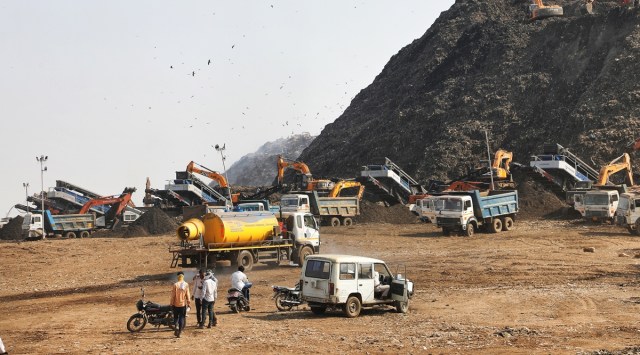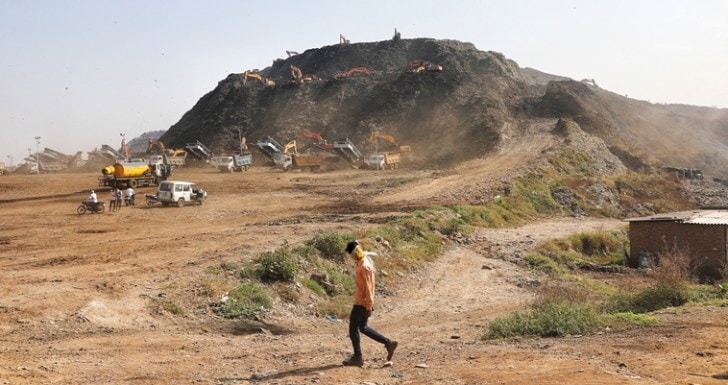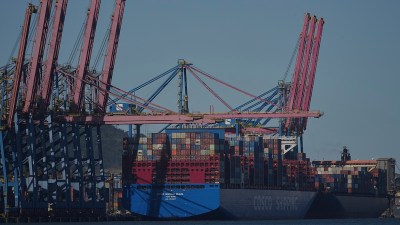Gujarat Hardlook: Reclaiming wasteland
Nearly 40 per cent of the legacy waste at Pirana, where Ahmedabad has been dumping garbage since the 1980s, has been cleared, as per rough estimates. Can the site get rid of piles of garbage soon enough with the eyesore at a prime location raising huge concern? Here’s a reality check by RITU SHARMA & SOHINI GHOSH
 AMC officials say they plan to clear the Pirana dump in the next three to five years. (Express Photo by Nirmal Harindran)
AMC officials say they plan to clear the Pirana dump in the next three to five years. (Express Photo by Nirmal Harindran) Over the last four decades, Ahmedabad’s entry point in Pirana village has metamorphosed to add stinking mounds of garbage reaching up to 50 metres in height. With the upcoming Mumbai-Ahmedabad Expressway set to pass by the site, the eyesore has heightened concern.
In the last three months, the Ahmedabad Municipal Corporation (AMC) has cleared around 35 acres of the total 85 acres of the landfill site. A government note had recently stated the value of the land is estimated to be around Rs 2,200 crore.
The garbage mounds, visible from kilometres away, emanate stench as one enters Ahmedabad from Mumbai. Locals say it has also become a health hazard.
 Pirana Landfill garbage dumping site in Ahmedabad. (Express photo by Nirmal Harindran)
Pirana Landfill garbage dumping site in Ahmedabad. (Express photo by Nirmal Harindran)
Criticised by environmental agencies and residents, the AMC – after years of deliberation – initiated a pilot project of biomining in January 2019 to get rid of the municipal solid waste.
In the AMC’s 2019 budget, an estimated amount of Rs 300 crore for ‘Pirana Dumpsite Remediation project’ was dedicated to the “capping” of the dumping site. The budget had proposed a ‘biomining project’ on a “Design, Build, Finance, Own and Operate (DBFOO)” basis. However, the AMC ruled out capping, considering that the leakage of trapped methane gases could harm the environment and emerge as a health hazard for people living around the site, Deputy Municipal Commissioner C R Kharsan told The Indian Express.
Sources, however, reveal that another reason why biomining was preferred over capping was the reclamation of land. Considering the prime location – at the gateway to the city and on a national highway — the reclaimed land has the potential to be developed for public projects or commercial set-ups in the future, said people in the know.
Work In Progress
In March 2019, the AMC invited tenders for supplying segregating trommel machines — each with a capacity of 300 TPD (tonnes per day) — on a rental basis for the biomining. Back in 2012, the AMC, in consultation with the United Nations Centre for Regional Development (UNCRD), developed the ‘Road Map for Zero Waste Ahmedabad – 2031’.
In January 2020, in the AMC’s draft budget for 2020-21, the then municipal commissioner Vijay Nehra for the first time gave a deadline for clearing the Pirana dumpsite by August 15, 2022, and added that another 20 lakh metric tonnes of garbage is expected to be cleared in that year. By March 2020, just before Covid struck, the AMC had announced that 10 lakh tonnes of waste had been removed and 8.5 acres of land had been reclaimed.
As per the AMC’s Solid Waste Management Department, over 95 lakh metric tonnes (MT) of legacy waste of 1.25 lakh MT has been cleared so far. Every day, 29,000 to 30,000 MT of legacy waste is processed at the site in two shifts on a war footing, as per people aware of the details. Sixty trommel machines of 300 MT capacity, and 11 automated segregation machines of 1,000 MT capacity working in two shifts — along with 63 excavators, and 267 Hyva trucks — are operating at the site.
The AMC has been using the 85-acre Pirana dumpsite on the Sewage Farm Road, which falls in Ahmedabad district on the outskirts of the city, for the last 43 years. Of the three landfill sites — Ajmeri dump site, which is near the Ajmeri Farm towards Narol-Sarkhej highway, High Dump where the dumping started, and the Excel mount near the Excel processing plant — the Ajmeri dumpsite is entirely cleared and 30 acres of land have been reclaimed while work has started on the High Dump site with around 50 lakh MT of waste has been cleared so far.
Ahmedabad Municipal Commissioner M Thennarassan told The Indian Express, “The reclaimed land will be used as an ecological park. Looking at years of waste being dumped at the site bacterial and toxic remediation of the soil will take some time”.
 A view of Pirana landfill garbage dump site. (Express photo by Nirmal Harindran)
A view of Pirana landfill garbage dump site. (Express photo by Nirmal Harindran)
As a relief for an estimated population of 3.5 lakh living in a radius of 3 km around the dumping site, plantation has already started on the two acres of reclaimed land at the site.
The civic body, however, faces an additional challenge with the city generating 3,000-3,100 MT of waste daily, which continues to be dumped at Pirana. Another 2,000 MT of construction and debris waste is generated for which a (Construction and Demolition) C&D recycling plant is operational near the dumpsite.
The Value In Waste
The National Green Tribunal (NGT), which in 2019 was dealing with the legacy waste issue of Pirana, had observed that the dumping site — when cleared — “may be worth more than Rs 1,000 crore.” The NGT had issued directions to the government to empty the landfill on a “war footing”. So far, 12.35 lakh MT inert from the biomining has been used by Sadbhav Engineering in the Dholera Expressway.
Under ‘waste to energy’ plan, the AMC will provide 2,000 MT of the waste under three different projects. “Once the waste-to-energy plant starts operations, the entire legacy waste will be done away with. We are taking the target of clearing the Pirana dump in the next 3-5 years. A waste-to-energy power grid plant using 1,000 MT is coming up near the Pirana dumpsite. Another 500 MT each would be turned into bio CNG by Adani and NAFED. These are also coming up near the dumpsite and expected to start operations within nine months,” Deputy Commissioner Kharsan said.
An official of Jindal Group-owned JITF Urban Infrastructure, which has signed an agreement with GUVNL and Torrent Group under PPA (power purchase agreement) for a period of 25 years, has revealed that a project is coming up at the site around 1.5-2 km distance from 180 MLD sewage treatment plant.
“This is our fifth project as four are operational in Delhi and Andhra Pradesh (Guntur and Vizag). Around 80 per cent of the work is complete and the plant is expected to be operational by March 2024. The power thus generated from the waste at the plant would be sent to the grid through 400 KV substation of Torrent around two km away,” the official handling the project said.
Kharsan added that the AMC also has plans for ‘waste to composting’ of around 500-800 MT that will be tendered soon. Expressions of Interest have been invited.
As per the Expression of Interest (EOI) for “300 TPD and above Capacity Municipal Solid Waste Processing with the use of any Technology at Pirana Dumping Site, Behrampura, Ahmedabad for a period of five years” document, the project has to comply with Solid Waste Management Rules, 2016, and applicable laws, rules, guidelines in India and best engineering practices through Public Private Participation (PPP).
“To improve the existing standards of public health and environmental quality by establishing technically suitable MSW processing plant for conversion of MSW to useful products compost /Biogas/ Energy / RDF/ Coal and recycling of recoverable material and safe disposal of residue inert waste as generated during waste processing at the earmarked position to be shown”, states the document.
Under biomining, first, the legacy waste is loosened using heavy machines. Then it is segregated and sorted for wastes like plastic, rubber, or wood which is converted into Refuse Derived Fuel (RDF), and the recyclable material like plastic, glass are sold to recyclers. RDF (Refuse Derived Fuel) is produced from combustible components or municipal solid waste MSW is the waste that is shredded, dried, baled, and then burned to produce energy.
At one time, waste from the mounds spilled out on the Piplaj-Pirana Road, dotted by farms and small and medium-sized workshops, warehouses, and factories, and connects to a national highway, especially worsening during monsoon. The road now is made of Reinforced Cement Concrete (RCC) lined with trees and pavements.
Citizen Nagar And A Disputed Shrine
Pirana is also where rehabilitated riot victims of 2002 reside. A few kilometres away from the landfill site lies Citizen Nagar, a Muslim neighbourhood where people who suffered in the 2002 riots were resettled.
The stench of garbage mixes with noxious fumes. Nadeem Saiyed (59), a resident, has been relying on a breathing apparatus since 2019. His interstitial lung disease worsens each day, he says.
From the rooftop of his three-storeyed house, barely a few 100 metres away, a towering garbage pile can be seen, enveloped in smoke.
His wife, Reshma, says, “The pile that has been cleared is the one which was facing the road that connects to the highway. On the other hand, this pile (behind her house) just keeps growing.” She points at how the mound, which now has shrubs growing along its incline, has a clear demarcation visible, where the “fresh” garbage is dumped on one side. “This mountain has only been growing since the past year, with hospital waste, dead animals, all of it making its way here,” she adds.
Factory sheds are also visible from the rooftop with smoke billowing from the units even on a Saturday afternoon. It gets worse at night, Reshma says, with the industrial units burning waste, including plastic. A truck full of garbage continues to increase the heap size. Eight km away from the landfill site, on the outskirts of the city, is the Pir Imamshah Bawa dargah, a mosque, a tomb, and a graveyard that has been embroiled in a communal dispute for the last two decades. In January 2022, hundreds of residents of Pirana village in Daskroi taluka of Ahmedabad took to the streets protesting the construction of a wall in the premises of Imamshah Bawa Sanstha Trust, replacing an earlier wired partition.
The Hindu followers of Pir Imamshah are known as ‘Satpanthis’ while the Muslim followers consider themselves to be descendants of Pir Imamshah Bawa. The protest was carried out by Pirana village residents – most of whom are Saiyed Muslims – alleging that the construction of the wall would cut off the access to the dargah from the mosque and graveyard on the premises.
A public interest litigation (PIL) was moved before the Gujarat High Court by the Sunni Awami Forum, highlighting that the Pir Imamshah Bawa has now been converted to “Shree Nishkalanki Narayan Tirthdham, Prernapith”, in contravention of the prohibition imposed by the Places of Worship Act. However, the PIL was dismissed last month, with the bench noting that the petitioner is making a property issue a “communal issue” instead.
Multiple Perils
In April 2017, a fire broke out in the garbage mounds, leading to panic in the area. Several residents at the time had demanded the closure of the landfill site. Months later, the then solid waste department director, Harshadray Solanki, suggesting biomining of the waste, had said at a public event on World Environment Day, “The health of nearby residents (around Pirana) can be compared to that of Hiroshima and Nagasaki residents following the bombings there. People living around Pirana have become very frustrated …We don’t need any enemies to bomb us, this (Pirana) is more than an atomic bomb.”
Frequent fires, illegal factory units and warehouses, and freak accidents – this has been part of everyday conversations for locals.
In July 2017, amid heavy downpour, around 2,500 MT of garbage had come sliding down from the Pirana dumping site onto the adjoining road, burying two scooters, a car, and an autorickshaw. In September 2020, in another tragic incident, a 12-year-old girl, accompanying her parents who were working at the dumpsite, had fallen through a pile of garbage, and her dismembered body was recovered a week later.
The nearest air quality monitoring station is at Gyaspur, nearly five km away and the Central Pollution Control Board’s (CPCB) data online indicates that the station records air quality ranging from ‘poor’ to ‘very poor’ in both parameters of particulate matter of 2.5 microns and 10 microns.
Litigations
In November 2016, Ahmedabad-based activist Kaleem Siddiqui had filed a public interest litigation in the Gujarat High Court seeking the removal of the dumpsite, saying it was putting lives at risk.
Responding to another PIL raising issues of mismanagement of solid waste and demand for shifting of the landfill site, the AMC had told the Gujarat HC in 2017 that people were “illegally living within 500 metres” of the site.
The PIL also alleged that the Pirana landfill site was not designed as per the existing Solid Waste Management Rules, 2016, and was not an engineered landfill, and that people in the locality were suffering from lung diseases and suffered premature death due to poor health conditions. However, by the time the litigation was taken up for hearing, the NGT was also seized of similar concern of pollution due to the landfill dumpsite.
In July 2019, taking cognizance of high pollution levels in Ahmedabad and noting that the average level of P.M 2.5 near Pirana “was beyond safe limits”, the principal bench of the National Green Tribunal (NGT) in New Delhi assigned “the highest priority” to tackle the waste at Pirana landfill, especially in view of the Swachchh Bharat initiative of the Central government. In August 2019, the NGT had given a timeline of clearing the entire dumpsite within a year against the AMC’s ask of 3-5 years. “Substantial progress must be made and demonstrated within six months,” the green tribunal emphatically said about four years ago.












